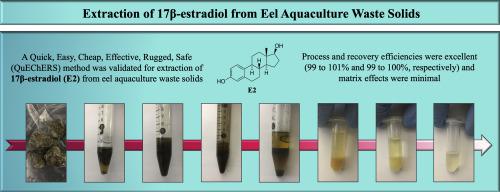Aquaculture ( IF 4.5 ) Pub Date : 2021-05-05 , DOI: 10.1016/j.aquaculture.2021.736873 Crystal L. Sweeney , Clarke A.M. Brown , Jessica L. Bennett , Neil W. Ross , Graham A. Gagnon

|
The use of 17β-estradiol (E2) in aquaculture feed increases growth and promotes feminization in freshwater eels. E2 and its metabolites (estrone (E1) and estriol (E3)) must be accurately measured in solid and liquid waste streams to ensure proper management. For reliable quantitation of estrogens in complex aquaculture waste solids, a rigorous clean-up method is imperative. The focus of this study was to assess, optimize, and validate a quick, easy, cheap, effective, rugged, and safe (QuEChERS) technique for extraction of estrogens from aquaculture waste solids and quantitation via liquid chromatography tandem-mass spectrometry (LC-MS/MS). Waste solids were collected from a recirculating aquaculture system containing American eels. Waste solids samples (2 g) were spiked to 50 μg kg−1 of E1, E2, and E3 and processed using 800 mg magnesium sulfate (MgSO4) and 400 mg of sodium acetate (NaOAc) as extraction salts. Two dispersive solid phase extraction (dSPE) steps were implemented to achieve optimal E2 recovery efficiency (RE (%)) in preliminary experiments (RE (%) = 102%; RSD = 5%). RE (%) for E1 and E3 were 87% (RSD = 54%) and 60% (RSD = 83%), respectively. Method performance characteristics were further assessed for E2 only and included specificity, linearity, accuracy (RE (%) and process efficiency (PE (%))), precision (intra-day precision, and inter-day precision), matrix effects, method detection limit (MDL), and limit of quantitation (LOQ). MDL and LOQ values for E2 were 0.7 and 2.3 μg kg−1, respectively. PE (%) and RE (%) were excellent (99–101% and 99–100%, respectively) and matrix effects were minimal (99 and 101%). The results of this study indicate that this method can be used for quantitation of E2 in aquaculture waste solids.
中文翻译:

从鳗鱼养殖废固体中提取17β-雌二醇的广泛净化方法,通过高效液相色谱串联质谱法进行定量
在水产养殖饲料中使用17β-雌二醇(E2)可增加生长并促进淡水鳗鱼的女性化。必须准确测量固体和液体废物流中的E2及其代谢产物(雌酮(E1)和雌三醇(E3)),以确保正确处理。为了可靠地定量复杂的水产养殖废固体中的雌激素,必须采取严格的净化方法。这项研究的重点是评估,优化和验证一种快速,简便,廉价,有效,坚固和安全的(QuEChERS)技术,用于从水产养殖废物固体中提取雌激素并通过液相色谱串联质谱法(LC- MS / MS)。从包含美洲鳗鱼的循环水产养殖系统中收集废固体。将废固体样品(2 g)加标至50μgkg -1用800mg硫酸镁(MgSO 4)和400mg乙酸钠(NaOAc)作为萃取盐进行处理。在初步实验中,执行了两个分散固相萃取(dSPE)步骤以实现最佳的E2回收效率(RE(%))(RE(%)= 102%; RSD = 5%)。E1和E3的RE(%)分别为87%(RSD = 54%)和60%(RSD = 83%)。方法性能特征仅针对E2进行了进一步评估,包括特异性,线性,准确性(RE(%)和过程效率(PE(%))),精度(日内精度和日间精度),基质效应,方法检测限(MDL)和定量限(LOQ)。E2的MDL和LOQ值分别为0.7和2.3μgkg -1, 分别。PE(%)和RE(%)极好(分别为99-101%和99-100%),基质效应极小(99和101%)。这项研究的结果表明,该方法可用于定量分析水产养殖废料中的E2。



























 京公网安备 11010802027423号
京公网安备 11010802027423号